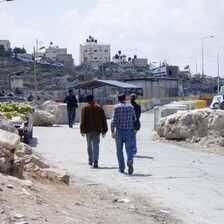During the last week of our stay, we decided to visit Tel Aviv. It was Easter Monday, and many Christians from all over Palestine were gathering to celebrate that holiday in the Arab city of Yafa, now mostly depopulated and surrounded by Tel Aviv. We decided to go with a group of our friends from Ramallah, all of whom, being Christian, were able to obtain the special Easter permits to travel to Israel. Visiting Yafa and Tel Aviv, two things stood in sharp contrast between the two neighbors. First, we were fascinated by the vast neighborhoods of modern buildings, beachfront hotels, and interesting modern architectural style of Tel Aviv. Judging by its buildings and beaches, Tel Aviv gives an impression of a wealthy international financial center, or a lush resort on the French Riviera.
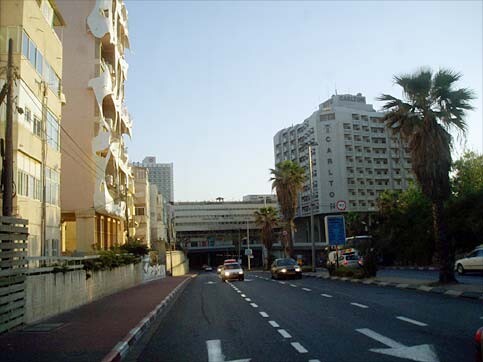
Tel Aviv beachfront hotels (April 12, 2004)
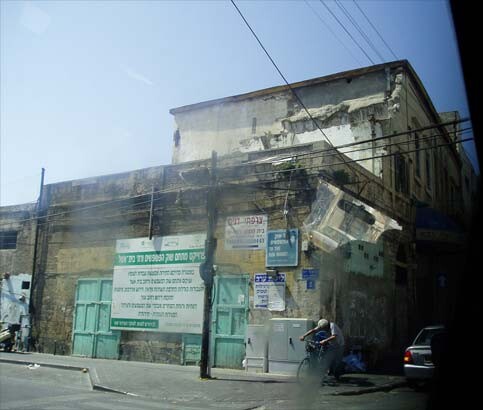
Arab Yafa - left to rot (April 12, 2004)
Turning to Yafa, it was like stepping into a third world slum, many of its buildings decaying and falling apart. With many of its buildings bearing marks of destruction from the 1948 war, Yafa was evocative of a real ghost city. Once “the Bride of Palestine”, its largest and most modern city, with gardens and beaches everywhere, and capital of the Jaffa orange industry, Yafa has been reduced to a decaying slum and center for drug-traffickers after most of its 100,000 inhabitants were forcefully evicted in 1948. The principal cause for the decline, apart from the exile of its people, is the annexation of Yafa into the Tel Aviv boundaries, ruled by the nearly 100% Jewish Tel Aviv municipal council. Over more than 55 years of domination, the council has issued few construction or renovation permits in Yafa, the most visible new construction favoring Jewish-owned hotels and restaurants, or the renovated and now Jewish-operated “Old City” complex. Very few of Yafa’s Arab inhabitants received those permits, meaning that Arab houses, mosques, churches, and other public buildings were simply left to rot and decay. Arabs venturing to build without a permit, even to fix a leak in the roof or add a room to house their children, risked their whole house being bulldozed by the Israeli authorities. That in a nutshell, is how Yafa was transformed into a slum.
Despite this decay, I couldn’t help notice how the citizens of Yafa were crowded outside on that Easter Monday, jubilantly celebrating the holiday, engaging in public parades, crowding the churches and the streets, and later picnicking in the parks and bathing in the beaches. It was an encouraging sight: despite all the oppression and the decay surrounding them, the Palestinian inhabitants and visitors of Yafa can still find the spirit to be alive and to enjoy the simple pleasures of life.
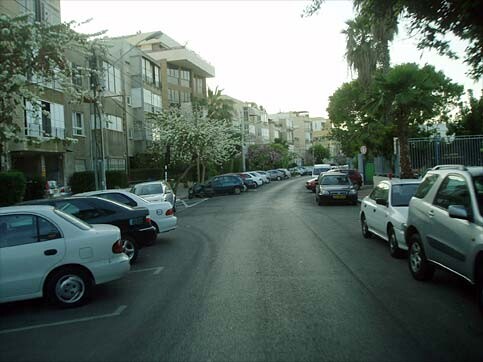
Desolate residential streets in Tel Aviv (April 12, 2004)
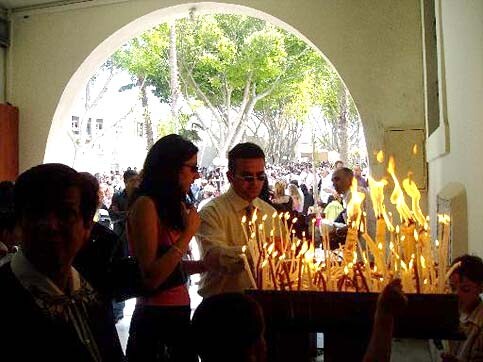
Crowded Palestinian-Christian churches in Yafa (April 12, 2004)
Contrast this to our impression of Tel Aviv. Underneath the fancy hotels and modern buildings, the streets were empty, the beaches deserted. Stores were closed and cars parked in front of homes. Perhaps it was because of the Pesach (Passover holiday), but then aren’t people supposed to be enjoying the holidays and going places? Throughout our stay in Tel Aviv, we could sense an edginess in the atmosphere. It had been more than two weeks since Israel assassinated the Hamas leader Sheikh Ahmad Yassin, and nothing had happened in retaliation. The very fact that no suicide attack had come yet seemed to imbue everyone with a sense that when it came, Hamas’s retaliation would be a major act qualitatively different from anything in the past. Everyone was walking around as if the sky was going to blow up at any moment. We could sense the fear overwhelming Tel Aviv. An ice cream store we attended even had a security guard employed to search customers as they enter at the door. Personally, of course, we were doubly worried, not only did we risk injury if any attack were to happen in Tel Aviv that day, but being Palestinians, we are the usual suspects and a convenient outlet for subsequent acts of revenge.
Still, I couldn’t help feel pity for the residents of Tel Aviv. Few children were to be seen on the streets, everybody locking their children at home out of fear. Rather than enjoy their lives, they were allowing their own fears to imprison them. Instead of dehumanizing us with the wall and the military oppression, they ended up dehumanizing themselves, like every good colonial occupier who thinks force alone can bring him security.
Despite the extreme vulnerability on the Palestinian side, I did not sense such an overwhelming fear as I did in Tel Aviv. The streets of Ramallah, Bethlehem, or even Arab East Jerusalem were relatively full of people going about their daily lives, and it was business as usual. Though sometimes people complain and wish they had a better life, most Palestinians I know sleep well at night. In Tel Aviv, knowing of the injustice they have inflicted and continue to inflict on the indigenous Palestinians, the Israelis do not enjoy that luxury. The assassination of Sheikh Yassin was supposed to terminate Hamas and bring them security. Instead, it only stirred their fears more. Walls surrounding all Palestinian towns and villages are not enough to abate this fear. It is as if every Palestinian shadow, every Arabic whisper, every Palestinian child born, is enough to send shivers through Israeli bodies. I got to experience that first-hand in Haifa. Standing atop a lookout on Mt. Carmel, among a few Jewish families, I exchanged one word of Arabic with our driver, something silly like “what time is it?”. Suddenly, within seconds, everyone there disappeared, out of fear. The spoken word has become a weapon.
Even before setting foot in Israel, on board the plane to Tel Aviv, and at the airport, we got to experience that Israeli fear. Everyone was suspicious. No Israeli could calmly close their eyes and sleep on the plane. Everyone was looking around, eyeing their neighbors, trying to eavesdrop on conversations, see if perhaps their neighbor is a “terrorist”. So it is with the soldiers at the checkpoints. They have to look behind their backs, even though they are armed quite well with modern weapons. Medieval-looking guard towers dominate the skyline of every checkpoint, with soldiers watching out behind armor-plated walls and bullet-proof glass lest any snipers target them.
While I may not pity the occupation soldiers, I do pity the children of Tel Aviv, having to grow up inside their homes in fear, not allowed to play outside, not allowed to go to the beach, simply because of some injustice their parents committed. I am saddened by the thought that they can entertain little hopes for their lives except to serve in the military like all other Israelis in order to perpetuate this surreal state of existence. I also do pity the children of the Palestinian refugee camps, who are born into a living Hell, surrounded by barbed wire and wall, cornered into poverty, and taught violence on their way to school by the occupation soldiers. I cannot even fathom the amount of hopelessness they must feel, growing up in a physical prison that they cannot break out of.
The end result is an Israeli society that evolves believing there is no alternative except a militaristic solution in which they unilaterally impose their will by means of their military superiority, and a Palestinian society that resents Israel’s militarism, yet after losing hope of a peaceful solution, and threatened with extinction, sees armed resistance the only way out.
Given all this, I find it disappointing and almost ridiculous that international politicians are still stuck in a labyrinth of partition plans, otherwise known as a “two-state solution”. Ever since 1947, so many solutions were proposed based on dividing the land between the two peoples: a string of UN resolutions, several US plans, the PLO plan of 1988 leading down to the Oslo accords of the 1990s, and recently to the impotent Mitchell Report, the still-born Roadmap, and finally to the aborted “Geneva Accords”. If anything, the fact that none of these plans have worked should be a testament to the futility of a solution based on dividing land as if one is dividing an apple. A two-state division is never clean-cut, forcing us to choose between ugly snaking borders like Israel’s modern Apartheid wall, cleaner-cut boundaries that leave many people on the wrong side, or forced mass migrations that leave wounds for generations. The two-state formula ignores the rights of individuals, seeking instead to cement an Apartheid system by creating another opposite Apartheid system. We have seen a two-state solution work too well in the Indian subcontinent, a solution whose 55 years of “success” has catalogued many deadly wars and is threatening the whole world with a nuclear holocaust.
In contrast, a much more reasonable compromise is the same solution that has eliminated Apartheid in South Africa and works reasonably well here in the United States of America: a single state, based on a constitution guaranteeing equal rights for all, regardless of ethnicity, race, or religion. Thus Jews wishing to legally buy land in Hebron and live there can do so, without the stigma of being called colonists and needing an army to impose their presence. Conversely, Palestinians like me originating from Yafa or Ramleh should be free to regain their parents’ lands and to settle there, if they so wished. The constitution has to protect the rights of minorities, while respecting the will of the majority, and has to guarantee equal rights for individuals.
In those countries like the USA that enjoy all the privileges of a free, constitutional democracy, and even take them for granted, opposition to one-state solution in Palestine/Israel is inexcusable. For many Americans, it is unthinkable to pass a law forbidding blacks from buying land in a certain area, or forbidding Latinos from marrying Whites. So why should the same Americans accept such discrimination as a “solution” to the conflict in the Middle East? Equality before the law and the right to vote are basic human rights that transcend national identity. No two-state solution comes even close to a single-state, South Africa-style union, in offering people so much freedom.
Dr. Saber Zaitoun is the pseudonym of a Palestinian-American in his thirties. Dr. Zaitoun grew up under Israeli occupation and first came to the USA during the first Intifada to finish his education. He is married, and currently teaches at a University on the East Coast. For more information about his visit to Palestine, please see www.triptopalestine.com.


